ICI Viewpoints
Investing Basics: Compound Returns and the Power of Reinvestment

As part of the ICI Education Foundation’s 30th anniversary celebration, we are sharing a series of ICI Viewpoints explaining basic investing concepts, drawn from the ICI Education Foundation’s Investing Road Trip.
Start saving early. You’ve heard it once, you’ve heard it a million times. There are a few reasons why that’s a good idea—to get in the habit, to manage risks to your investments and income, and to allow more time to contribute to your savings and let them grow. But the strongest case for starting early boils down to one phrase: compound returns.
Compounding: The Miracle, the Magic, the Power?
I’ve heard all these words used to describe compound returns. (OK, maybe I’ve even used them myself.) Is it hype or is it real? Let’s take a look.
A return is the money you earn on an investment. But compound returns are when things start to get fun. Compounding refers to the return you get by investing a return you’ve already earned. When you reinvest returns, those returns start earning returns of their own.
Compare simple and compound returns in this example from ICI Education Foundation’s Investing Road Trip: you invest $100 at 5 percent annual interest. At the end of a year, you’ve earned $5. You pocket your $5 and invest your $100 for another year. After two decades, you’ll have your original $100 plus 20 years of $5 earnings—a total of $200.
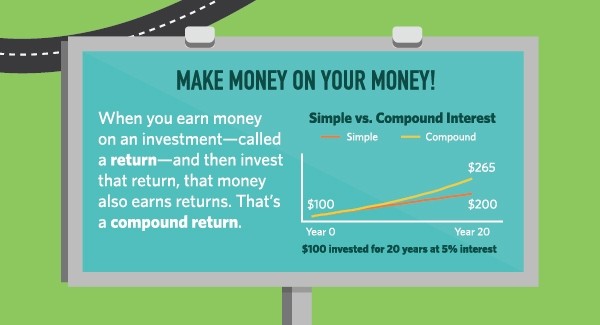
What if, after that first year, you invest the $5 return on top of the original $100? During the second year, you’ll earn $5.25, with your earnings coming from not only on the original $100 investment, but also on the $5 of first-year earnings. It’s tiny in this example, but the $0.25 difference between what you earned in year one and what you earned in year two is the effect of compounding. Over the course of 20 years, your $100 investment would have grown to $265, or $65 more than if you had not reinvested the earnings.
Over long periods of time, compounding can produce significant growth in the value of an investment. Here are four examples that show the positive effects of compounding.
The Power of Time
Consider two investors who both invest $1,000. The first investor makes a one-time investment of $1,000 and leaves it to grow for 40 years. The other starts 20 years later with a $1,000 investment, but then lets it grow for the next 20 years. (In this and the following examples, we’ll ignore the effects of taxes and inflation and assume returns of 7 percent per year.)
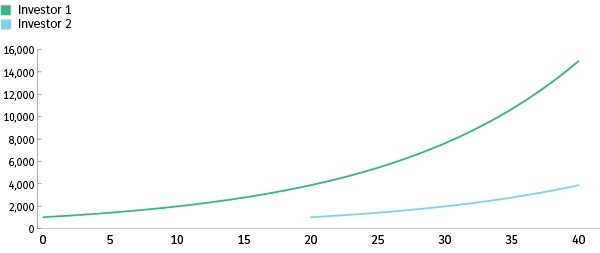
At the end of 40 years, the first investor has $14,975, while the second investor has $3,870. Each investor sets aside $1,000, but they end up more than $11,000 apart.
The Power of Regular Contributions
But most people don’t invest just once—they make regular contributions year after year.
The following graph shows three investors; each invests $1,000 a year until age 65. However, one begins at age 25, investing a total of $40,000; one at age 35, investing a total of $30,000; and one at age 45, investing a total of $20,000.
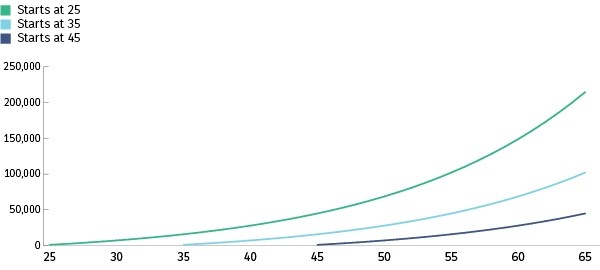
The earliest investor—who saves regularly and allows compounding to work over time—retires with more than double the one who waits until age 35 and more than four times the one who waits until age 45.
The Power of Starting Early
What if you start late but contribute more—how easy is it to make up for lost time? Let’s say one investor starts at age 25, contributing $1,000 each year for 10 years, then adds nothing more for 30 years. The other starts at age 35, contributing $1,000 each year for 30 years until age 65.
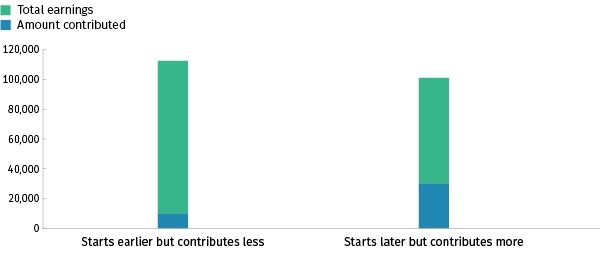
At age 65, the fast starter ends up with 11 percent more money—even though that investor only invests one-third as much as the one who starts later. The sooner you start, the less you need to save to reach your goal.
The Power of Little by Little
As discussed in last month’s post, college tuition costs can make saving for a child’s education a daunting goal. But with time on your side, this long-term goal is much more attainable.
Suppose, when your child is born, you set aside $100 a month toward future education costs.
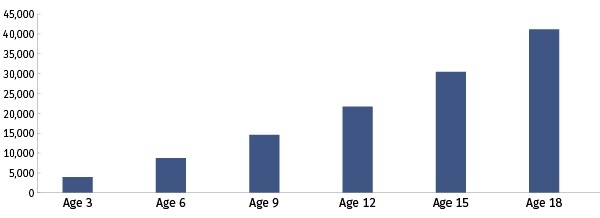
By the time your child is 18, your $100-a-month account has grown to more than $41,000—thanks to steady contributions and compounding.
According to data compiled by the National Center for Education Statistics, the average total cost of attendance in academic year 2018–2019 for first-time, full-time undergraduate students living on campus at four-year public institutions was $24,900 (costs are significantly higher at private nonprofit institutions at $51,900). For students who received federal grant and scholarship aid, the average net price for first-time, full-time students was $13,700 ($27,000 at private nonprofit institutions).
While it would likely not cover all costs, saving $100 per month would set college-bound students firmly on the path to financing their educations.
***
Starting early and saving regularly, even in small amounts, lets the power of compound interest work for you, so you can reach your financial goals with less saving effort.
Other Posts in This Series
- Investing Basics: What Is Investing?
- Investing Basics: What Is Risk?
- Investing Basics: Types of Investments
- Investing Basics: Diversification
- Investing Basics: Dollar-Cost Averaging
- Investing Basics: Benefits of Mutual Funds
- Investing Basics: Tax Benefits to Encourage Saving
- Investing Basics: 529 Savings Plans
- Investing Basics: Compound Returns and the Power of Reinvestment
- Investing Basics: Understanding Fees and Expenses
Christina Kilroy is the Vice President of the ICI Education Foundation.
